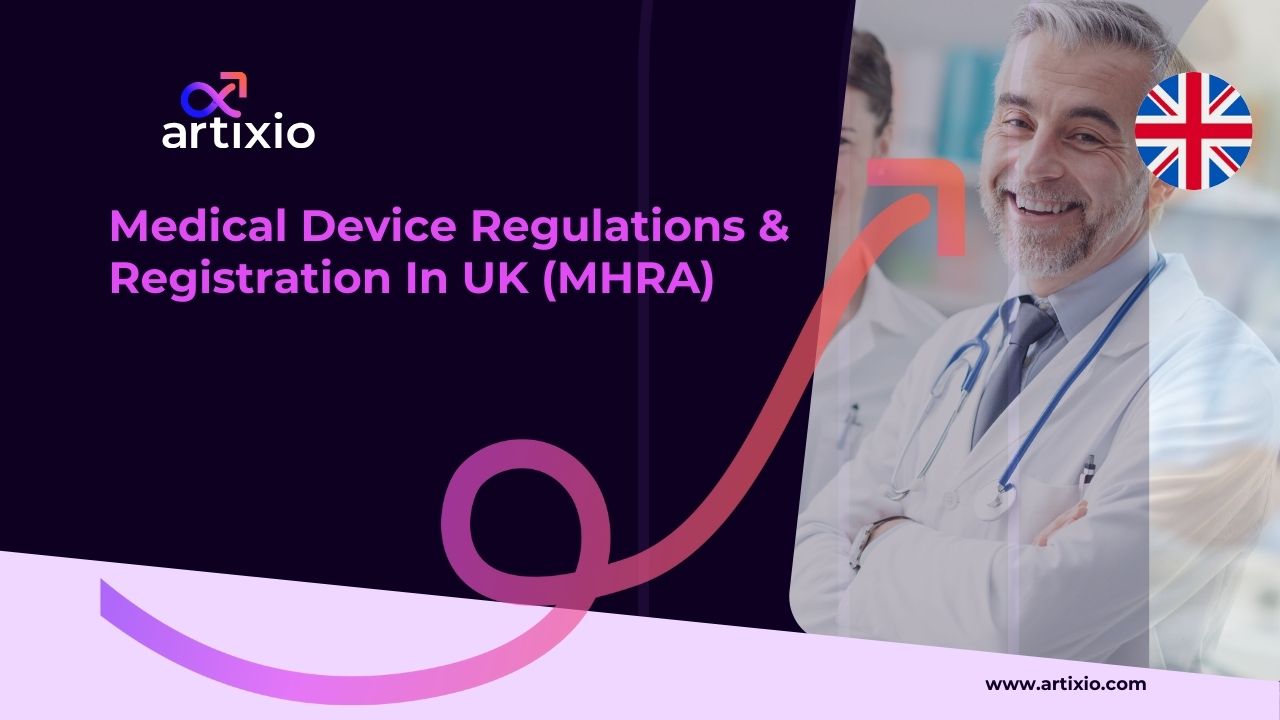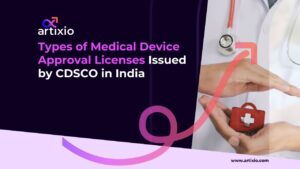Medical Device Regulations and Registration Process in the MHRA United Kingdom (UK)
- The publicly funded National Health Service (NHS) is the largest purchaser of medical technology which accounts for approximately 85% of the country’s healthcare provision.
- Market value of medical devices in the United Kingdom is estimated to reach US$17.52bn by the end of 2023 with Cardiology Devices holding a market share of US$2.48bn.
- By 2028, revenue is expected to grow with a compound annual growth rate (CAGR) of 3.82%, resulting in a market volume of US$21.13bn.
Medical Product Regulatory Authority in the UK
Medicines & Healthcare Products Regulatory Agency (MHRA) is an executive agency under the UK’s Department of Health and Social Care (DHSC) responsible for ensuring the safety, quality, and efficacy of medicines, medical devices, and healthcare products available in the UK market. Medical devices such as in-vitro diagnostics, and custom-made devices must abide by the Medical Devices Regulations 2002 (UK MDR 2002).
Classification of Medical devices
Class I category includes low-risk devices that do not have a direct or invasive effect on the human body. Class I devices are non-invasive tools like stethoscopes, bandages, and tongue depressors. These devices are subject to basic regulatory controls and self-declaration of conformity by the manufacturer.
Class IIa devices are considered to have a moderate level of risk. They include devices such as contact lenses, pregnancy test kits, and hearing aids.
Class IIb category comprises devices with a higher level of risk compared to Class IIa. Class IIb devices include devices like active implantable pacemakers, X-ray machines, and infusion pumps. Manufacturers of Class IIa and Class IIb devices must apply conformity assessment procedures specified by the UK regulatory authority, which may involve testing by a notified body or other authorized entities.
Class III devices represent the highest level of risk, and are typically invasive or life-sustaining devices. Examples of class III devices include heart valves, implantable defibrillators, and certain advanced diagnostic imaging devices. Manufacturers of Class III devices must undergo more rigorous conformity assessment procedures involving a notified body or other authorized entities.
Medical Device Labeling requirements In UK
For Class I devices, the labeling requirements include the following information:
- Manufacturer’s name and address
- Device name or trade name
- Device model or catalogue number (if applicable)
- Batch or lot number (if applicable)
- Instructions for use, including indications, contraindications, and precautions
- Storage conditions (if applicable)
- The statement “CE Mark” or the UKCA mark, indicating compliance with applicable regulations
- Any additional information required by relevant national regulations
Class IIa, IIb, and III devices Labeling Requirements:
The labeling requirements for Class IIa, IIb, and III devices are more comprehensive compared to Class I devices. In addition to the requirements of Class I devices, the labels of these devices should include:
- Summary of the device’s intended purpose and its clinical benefits
- Essential characteristics and performance data
- Details of any specific warnings, precautions, or limitations
- Information on any specific storage, handling, or disposal requirements
- Reference to any instructions for use or user manuals
- Reference to any applicable standards or regulations
- Identification of the notified body involved in the conformity assessment process (for Class IIb and III devices)
Conformity Assessment for Class IIa, IIb, and III medical devices
For higher-risk devices such as Classes IIa, IIb, and III, the involvement of a notified body may be required for the conformity assessment. The notified body is an independent organization designated by the UK regulatory authority, MHRA. The conformity assessment process may involve the following steps:
Design Examination: The notified body examines the design documentation to verify that the device meets the essential requirements and relevant standards.
Type Examination: The notified body assesses a representative sample of the device or the entire device to verify compliance with the relevant standards.
Production Quality Assurance: The manufacturer establishes and maintains a quality management system that ensures the device’s conformity during production. The notified body assesses and certifies this quality management system.
Full Quality Assurance: This assessment is applicable for Class III devices and certain implantable devices. The manufacturer’s quality management system and the production process are subject to ongoing surveillance and scrutiny by the notified body.
Product Verification: The notified body may also conduct sample testing or verification of the device’s performance and safety characteristics.
UKCA Marking: Upon successful completion of the conformity assessment, the manufacturer affixes the UKCA mark to the device. The UKCA mark indicates that the device meets the necessary requirements to be placed on the UK market.
Unique Device Identification (UDI): Medical devices may need to be assigned a Unique Device Identification (UDI) code, especially for higher-risk devices. The UDI is a unique identifier that allows for traceability and enhances post-market surveillance. Manufacturers must comply with UDI requirements as outlined in the UK UDI regulations.
Clinical trials requirements
Ethical Approval: Before starting a clinical trial, it is essential to obtain ethical approval from a recognized Research Ethics Committee (REC). Ethical approval ensures that the trial is conducted in a manner that protects the rights, safety, and well-being of the trial participants.
Investigational Device Exemption (IDE): If the medical device is not yet approved for commercial use in the UK, an IDE from the MHRA must be obtained. The IDE allows you to use the device in a clinical trial setting before it receives regulatory approval.
Clinical Investigation Authorization (CIA): If the medical device is not yet approved for commercial use in the EU or the UK, the application must be submitted to the Clinical Investigation Authorization (CIA) for seeking permission to conduct the clinical investigation within the UK.
Informed Consent: Participants in the clinical trial must provide informed consent before participating. Participants must be givens clear and comprehensive information about the purpose, risks, benefits, and procedures involved in the trial.
Safety Reporting: Adverse events occurring during the clinical trial must be promptly reported to the MHRA and the relevant REC. Safety reporting includes any unexpected or serious adverse events that may be related to the medical device under investigation.
Data Collection and Reporting: Clinical trials should be conducted according to a detailed protocol that outlines the study design, objectives, methodology, and data collection procedures. The trial data must be accurately recorded and reported in compliance with Good Clinical Practice (GCP) guidelines.
Product Testing Requirements:
Performance Testing: Performance testing assesses the device’s functionality, accuracy, reliability, and other performance characteristics. The testing methods should be appropriate depending on the type of device and may include mechanical, electrical, biological, or other relevant tests.
Biological Safety Testing: For devices that come into direct or indirect contact with the human body, biological safety testing is often required. This testing evaluates the potential risks posed to the human body with the device’s materials and components. Common tests include cytotoxicity, sensitization, irritation, and biocompatibility assessments.
Usability and Human Factors Testing: Usability and human factors testing evaluate how well the device can be used by its intended users. It focuses on factors such as user interface design, ergonomics, and user comprehension. These tests aim to ensure that the device is safe and easy to use in real-world scenarios.
Sterilization and Packaging Testing: If the device requires sterilization or is packaged in a sterile manner, testing should be conducted to validate the sterilization process and ensure the integrity of the packaging. This includes assessing the sterility assurance level, packaging integrity, and shelf-life stability.
Software Testing: If the medical device incorporates software, additional testing may be required to evaluate its safety, reliability, and performance. This may include software verification, validation, and risk analysis to ensure that the software functions as intended and does not pose any risks to patients.
Good Distribution Practice (GDP) and Good Manufacturing Practice (GMP) Requirements:
Good distribution practice in the UK is regulated by the MHRA. GDP guidelines ensure products are obtained from the licensed supply chain and are stored, transported, and handled under suitable conditions, as required by the MA or product specification. GDP Documentation should be comprehensive to enable complete traceability of products across distribution channels. All parties involved have to be readily identifiable. All documents and records such as dispatch and receipt must be kept for 7 years.
The MHRA adopts a risk-based approach for conducting GMP inspections. On successful inspection, organizations are given GMP rating or scores which is based on the compliance report, internal information about previous inspection history, and organizational changes.
After the inspection, a post-inspection letter is sent to the organization stating any deficiencies found in GDP or the GMP. The Organization must respond to the inspector by email with the proposed corrective actions and dates for when these actions will be completed. The inspector will review the response and issues a GMP or GDP certificate with your inspection report. An unacceptable response may lead to compliance escalation if further requests for information are unsatisfactory.
Medical Device Registration Process In UK
Technical Documentation Compilation: Manufacturers are required to compile technical documentation that demonstrates the device’s compliance with the essential requirements of the Medical Device Regulations. The documentation includes:
- Manufacturer details
- Device details including device’s design, intended use, labeling, and instructions for use,
- Declaration of Conformity (DoC)
- Product Description
- Technical File
- Label, IFU, and User Manual
- Letter of Authorization
- Clinical Studies results
- CE Mark or UKCA mark
- Risk Management Plan
- Post-market surveillance
- General safety and performance requirements
- Performance test reports
- Product verification and validation
- Biocompatibility, Sterilization Information (if applicable)
Appointing a UK Responsible Person (UKRP): Manufacturers based outside the UK must appoint a UK Responsible Person (UKRP) if they do not have a registered place of business in the UK. The UKRP acts as a representative for the manufacturer and ensures compliance with UK regulatory requirements.
Online Registration: The registration process is completed through the MHRA’s Medical Device Information System (MDIS), an online portal. Manufacturers or their appointed UKRP should create an account on the MDIS platform and provide the required information, including details about the device, manufacturer, and technical documentation.
Timelines and fees: A statutory fee of £240 is applicable for the registration application. Companies can submit up to 100 device registration applications for the fee of £240. MHRA quotes about 5 business days to review the application.
Review and Assessment: Once the registration application is submitted, the MHRA reviews the documentation and assesses the device’s compliance with the regulatory requirements. The assessment process may include a review of the technical documentation, labeling, and clinical data (if applicable).
On successful registration of the medical device, the manufacturer and the device are listed on the MHRA registration database. The registration must be renewed one year post granting approval and renewals must be made every two years.
Import requirements
Before importing and distributing a medical device in the UK, it must be registered with the MHRA. The registration process involves submitting the necessary information and documentation, including details about the device, manufacturer, and technical documentation, through the MHRA’s Medical Device Information System (MDIS).
Does FDA-approved medical devices have an advantage?
A medical device approved by the FDA does not directly expedite the registration process in the UK. Since the regulatory requirements and registration process in the UK are specific to the UK. However, the data and documentation generated through the FDA approval process can be produced as part of the technical documentation required for UK registration.
Post Approval changes for medical devices
Vigilance Reporting: Manufacturers, importers, and distributors have a legal obligation to report MHRA of any adverse events, field safety corrective actions (recalls), and trends related to adverse events or product issues associated with their medical devices. Prompt reporting ensures that potential risks or issues are identified and appropriate actions are taken to protect patient safety.
Periodic Safety Update Reports (PSURs): Manufacturers of higher-risk medical devices are required to submit Periodic Safety Update Reports to the MHRA. PSURs provide a comprehensive assessment of the device’s safety and performance based on data collected during its post-market use.
Renewal: MHRA has introduced a renewal registration process to enable representatives to review the registration and ensure that it is up-to-date. Email reminders are sent to the representatives to remind you of the registration. If the renewal of the device registration is not submitted timely, the account will be suspended.
For more information on the regulatory approval process, get in touch with Artixio and to learn more about the regulatory process in the United Kingdom.
References:
https://www.gov.uk/government/organisations/medicines-and-healthcare-products-regulatory-agency





